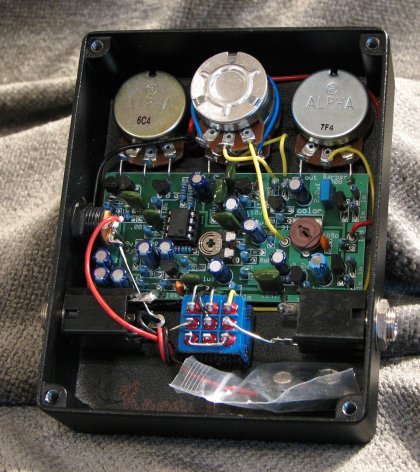The Barber Tone Press Compressor

The sound of compressed guitar is nearly unbiquitous in popular music. In the studio, guitars are compressed so often that it’s rare to hear one that isn’t compressed. Some players have built a big part of their signature sounds around stomp-box compressors. For example, towards the end of the ‘70s, the clean or moderately clean but compressed sound was made famous by the likes of Larry Carlton, based around his Gibson ES-335, and David Gilmour, based around his Fender Strat. Many of us have used compressors on our electric guitars to increase sustain without driving the power amp to the wall. However, when you start fiddling with basic two-knob guitar compressors, you soon notice that their sustain comes at the cost of squashing the living daylights out of the stronger attack phase of the guitar’s signal, killing off the bloom of overtones and causing a “pop”. You can hear that on early recorded examples and when you play through many stomp box compressors. One easy to spot example of the pop is found on David Gilmour’s “Shine On You Crazy Diamond” intro solo sound. Over the years, manufacturers have tried various schemes to counteract this phenomenon, usually centering around placing a variable delay on the onset of the compressor to allow the attack to slip through before the effect takes hold. It works, but can be hard to manage as you vary your attack and so can often still sound kind of funky.
Recently, small-shop effects builder David Barber has come up with something to address the problem of the pop. Based on a studio practice involving routing a signal to two channels and compressing only one, his idea is to blend the uncompressed signal with the compressed signal within the pedal while keeping them phase-coherent. When properly blended with the compressed signal, the uncompressed signal provides the bloom of overtones and attack and drowns out the pop. Then it naturally fades under the compressed signal as the compressed signal continues to sustain. A “Blend” control, really a post-effect mixer, allows you to blend between the uncompressed and compressed signals. Sweet! The “magic” is in the ability to maintain phase coherency throughout the system so there is no phase cancellation.
 Barber suggests placing tape over the battery snap if you
Barber suggests placing tape over the battery snap if you
use the pedal without a battery. I used a tiny ziplock bag.
The Barber Tone Press pedal is a hand-built pedal housed in a strong, crinkle-finished Pbox with a sturdy footswitch, pots and jacks. The pedal’s components live on one cleanly designed double-sided PC board. The design features a true bypass circuit driven by a sturdy DPDT switch, so your signal is completely unaffected by the unit when you bypass it. You can choose between battery power and an optional wall supply via a barrel jack for a standard Boss-type negative-tip 9-volt external power supply. A front panel LED is provided to tell you when the unit is engaged. There are four controls: Level, Blend, Sustain, and Color, with the last being a trim pot inside the box. As described, “Blend” mixes between compressed and dry sound. At 12 o’clock, it is an even mix ‘twixt the two. “Level” sets the overall operating level of the unit. When the blend control is set at 7 o’clock (dry, no compression) and Level is set above unity (2 o’clock) the unit can function as a clean boost pedal. “Sustain” functions like the sensitivity control on most stompbox compressors, combining a compression ratio control with a gain make-up so that as you compress more and more, the overall level remains constant.
So, how does it sound? It does exactly what it says it does and does so unremarkably, with few noticeable artifacts. And that unremarkable quality is at the heart of this pedal. At 12 o’clock on the blend control, you get marvelous sustain with natural attack and no odd transition between the two. Unless you intentionally crank everything up to full, the effect is so subtle and there is so little background noise that at first you aren’t exactly sure the pedal is even engaged. Hello! And then you hold a note. Ahh! Gobs of smooth sustain. Now THIS is how compression is supposed to be. Very subtle - much like an expensive studio unit. Very nice, indeed. If you want to compress the poop out of things and maybe want that little “pop” caused by the artifacts, just twist the Blend fully to the right and you are back in hard compression land.
Now, what about that “Color” control inside the box? Well, that’s interesting. The unit is shipped with the color control at full-on, in which position it affects the EQ of the signal very little. According to the manual, backing it down imparts a round, “vintage quality” to the compressed chain. According to David, it is a high frequency roll-off that affects the compressed side of the signal only. I prefer the sound wth the trim opened all the way.
So, we have here a remarkable piece of design and construction that accomplishes everything it set out to do but almost underwhelms you with its elegant simplicity. And once again, a creative designer has upheld Arthur C. Clarke’s notion that “Any sufficiently advanced technology is indistinguishable from magic.”

BARBER ELECTRONICS
= =
=





